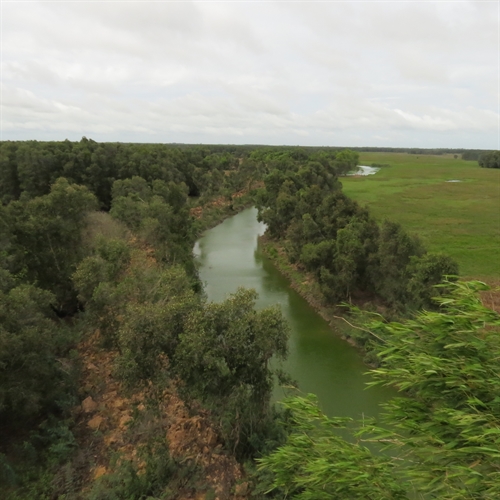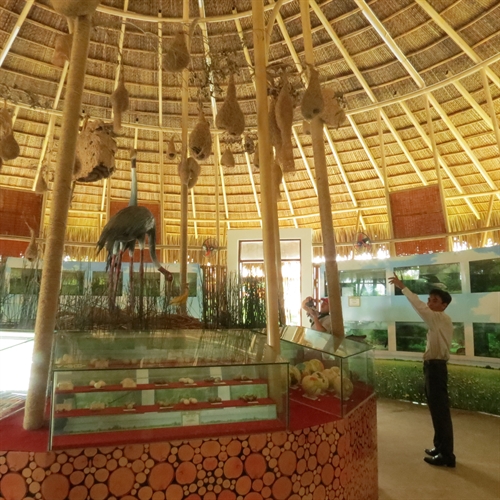 Life & Style
Life & Style

Recent rains have eased droughts affecting biological diversity at two protected sites: the Láng Sen Wetland Reserve and Tràm Chim National Park in the Mekong Delta provinces of Long An and Đồng Tháp.
 |
| Drought easing up: Đồng Tháp Province’s Tràm Chim National Park is the last remnant of the Plain of Reeds wetland ecosystem recognised as a Ramsar wetlands site of international importance. — VNS Photo Gia Lộc |
by Gia Lộc
HCM CITY — Recent rains have eased droughts affecting biological diversity at two protected sites: the Láng Sen Wetland Reserve and Tràm Chim National Park in the Mekong Delta provinces of Long An and Đồng Tháp.
Nguyễn Công Toại, deputy head of the Láng Sen Wetland Reserve, said the rains created favourable conditions for the reproduction of fish and growth of mangrove fields, water chestnuts, rice crops and grasslands.
The more than 4,800ha reserve is one of Việt Nam’s eight Ramsar Convention sites - an international agreement on the conservation of wetlands which Việt Nam signed in 1989.
It is home to 148 kinds of water birds, including endangered kinds in Việt Nam’s Red Book, such as the greater adjutant and red-crowned crane, and 20 kinds of fish.
“The annual flooding season’s water level entering into wetlands last year was lower than usual because of climate change and dams on the upper Mekong River, leading to a shortage of water and facilitating saline instruction,” Toại said.
The prolonged and severe heat wave during the first half of this year, which was caused by the El Nino phenomenon, dried up several areas in the reserve, he added.
“To maintain habitats for fish and water birds, as well as lotus and others, we pumped water taken from canals outside the reserve. It was the first time we did this,” he said.
The cost of continuous pumping over the course of three months was nearly VNĐ200 million (US$8,890), he added.
The situation was similar at another site recognised by the Ramsar Convention - Tràm Chim National Park near the Láng Sen Reserve, where staff have also pumped water into the park since February.
Tràm Chim Park covers 7,313ha with 232 species of birds and 130 kinds of fish, including 40 species that are globally threatened, including the Bengal florican and Siamese giant carp.
Nguyễn Hoàng Minh Hải, head of the park’s science and international co-operation division, said many fish in the park died due to a shortage of water.
“Such extraordinary weather over the past five to seven years has not been good for the park’s habitat to develop, and has increased the risk of forest fires,” Hải said, adding that four fires this year destroyed tens of hectares, mostly grasslands.
Under the influence of these climate changes, the park has seen a decrease in the number of red-crowned cranes migrating to the park each year.
There were only 14 this year, compared to 1,052 cranes in 1989.
Lê Phát Quới of HCM City Natural Resource and Environment department, who is researching and preserving the Láng Sen Reserve, said severe droughts and saline intrusion would continue to change the habitats and ecosystem of the two Ramsar sites.
“The Láng Sen Reserve is always damaged by saline intrusion more than Tràm Chim because the former is located in a lowland region surrounded by the Vàm Cỏ Tây River,” Quới said, adding that saltwater easily enters the reserve via the river.
"Moreover, the reserve’s many areas are affected by alum caused by the drought," he added.
 |
| Fish and bird sanctuary: A fresh water aquarium and egg collection are displayed at the exhibition house at Đồng Tháp Province’s Tràm Chim National Park. —VNS Photo Gia Lộc |
The recognition of wetlands within Láng Sen Reserve and Tràm Chim Park as two Ramsar Convention sites is of great international importance, requiring the conservation and sustainable utilisation of wetlands under the treaty.
According to Quới, the two Ramsar sites will continue to see a higher risk of forest fires, which kill the wetland’s habitats for animals, particularly water birds.
The Ramsar sites are divided into smaller square-shaped areas by dykes to make it easier to hold and regulate water.
“On the contrary, this division separates their ecosystem and causes difficulties in water circulation,” Quới said.
In Tràm Chim Park, he advised staff to remove several 100-metre sections of dykes to improve the water circulation between the grasslands and fields and increase water sources for water birds and fish.
“After three months, the park has seen an increase in the number of water birds migrating there,” he added.
Toại of the Láng Sen Reserve said sluices for regulating water in the reserve were planned for construction.
Hải said that the Đồng Tháp Province People’s Committee approved plans for the conservation of biodiversity at the park in order to adapt to climate change impacts by 2020.
Eco-tourism in the two parks has been encouraged and developed, with its value outweighing the negative effects such as noise.
“It also helps reduce the illegal entry of residents, especially ones at the buffer zone on the park’s perimeter, aiding the conservation of wetlands,” he added.
In Láng Sen Reserve, 3,241 families live in buffer zones, most of them near the poverty level.
Many of them receive help to plant huyết rồng (red rice), which helps them earn VNĐ40 million (US$1,780) per crop.
“It is worth noting that they stopped using chemicals in cultivation, leading to the development of natural fish in their rice fields, which is extra income for them,” Quới said.
This method causes no pollution to water sources in the reserve, he added. — VNS




